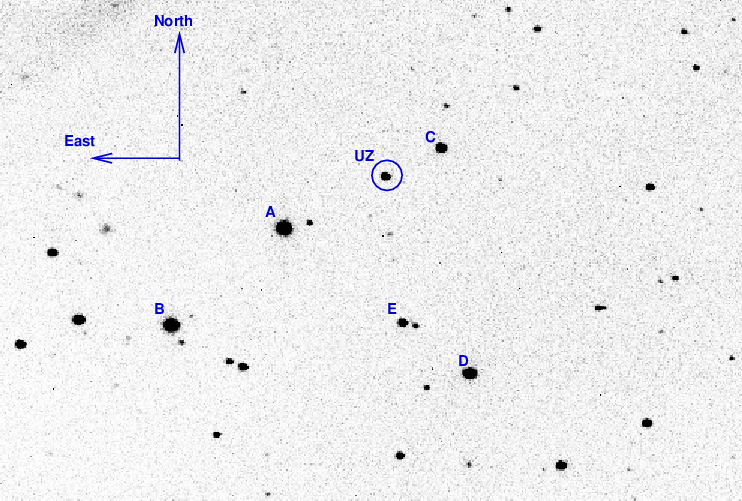
On the night of Aug 15/16, 2013, I observed UZ Boo and SN 2013ej in M74. Conditions were fair -- some clouds early and late, and one minor equipment mishap.
The main setup was:
Notes from the night
I took a series of images of UZ Boo, using a 90-second exposure time, since UZ Boo has been brighter recently. Tonight, the star was fading again, reaching mag V = 15.3 or so; I may need to increase the exposure time again.

The zero-point offset graph shows clouds early, causing the gap, and then gradually increasing airmass. The high points between JD 1520.63 - 1520.645 are due to a taut cable ruining the tracking.
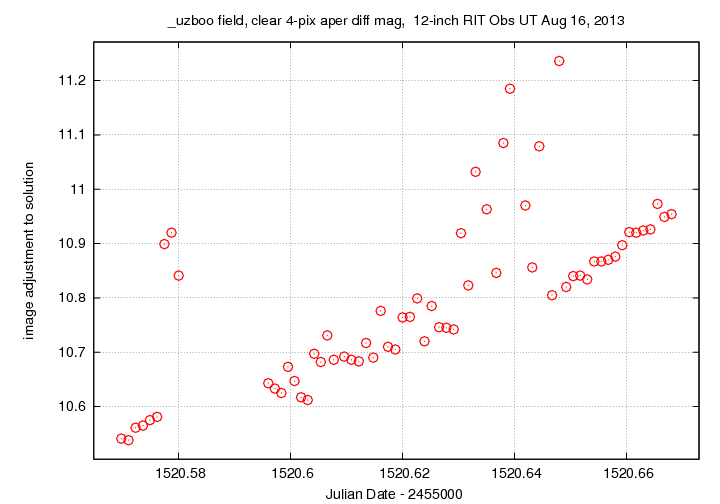
I measured UZ Boo and many other stars in the field. The bright stars "A", "B" and "D" were somewhat saturated, so I left them out of the ensemble solution. Instead of the star "A", I used the star "E" = UCAC4 561-055129 = AAVSO 000-BBV-649 to shift the instrumental magnitudes to the standard scale. Remember, the measurements are made without a filter , but I'll shift them to match the V-band scale: 000-BBV-649 has mag V = 14.267 according to the AAVSO chart 12447AMF.
Below are light curves for UZ Boo and several of the unsaturated stars in the field:
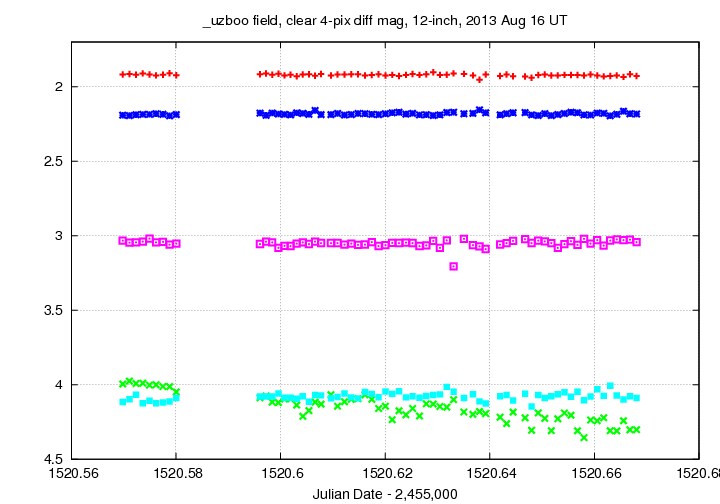
Here's a closeup of UZ Boo and another star:
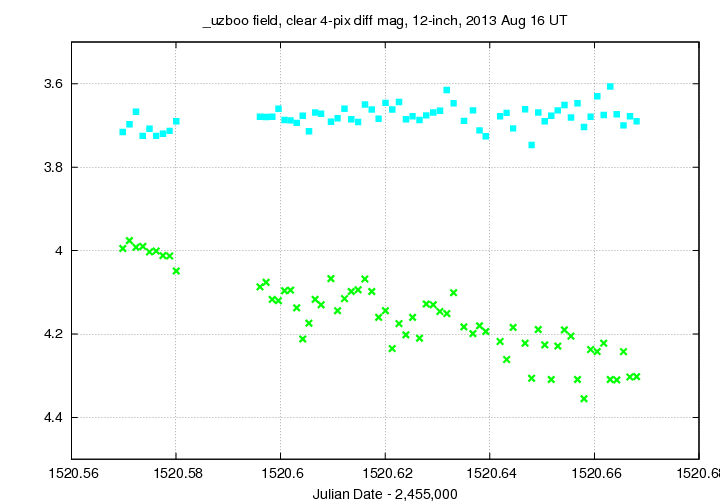
The variable star has entered a phase in its evolution in which it fades by about 2 mag, then rebrightens, then fades again, then rebrightens, etc. My measurements at the RIT Observatory catch UZ Boo at several places in this complicated evolution; tonight, it was fading.
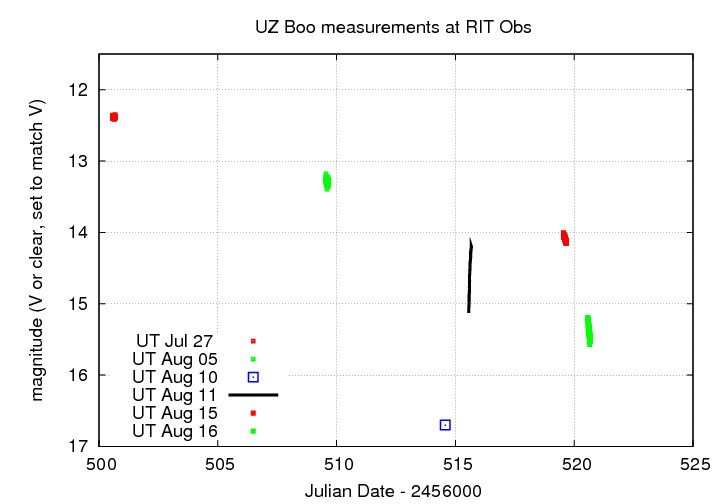
Below are the first few lines of the report I've sent to the AAVSO and VSNet.
# Measurements of UZ_Boo made at RIT Obs, Aug 16, 2013 UT, # in poor conditions, # by Michael Richmond, using 12-inch Meade and SBIG ST-8E CCD. # Exposures 90 seconds long, clear filter. # Tabulated times are midexposure (FITS header time - half exposure length) # and accurate only to +/- 1 second (??). # 'mag' is a differential magnitude based on ensemble photometry # using a circular aperture of radius 7.4 arcseconds. # which has been shifted so UCAC4 561-055129 has mag=14.267 # which is its V-band magnitude according to AAVSO. # # UT_day JD HJD mag uncert Aug16.06980 2456520.56980 2456520.56796 15.212 0.026 Aug16.07109 2456520.57109 2456520.56925 15.193 0.026 Aug16.07236 2456520.57236 2456520.57052 15.209 0.026 Aug16.07365 2456520.57365 2456520.57181 15.207 0.027
SN 2013ej is a Type II supernova in the relatively nearby galaxy M74. It was discovered by the KAIT group some time (a week?) before maximum light. Here's a chart showing the galaxy, the SN, and some reference stars:
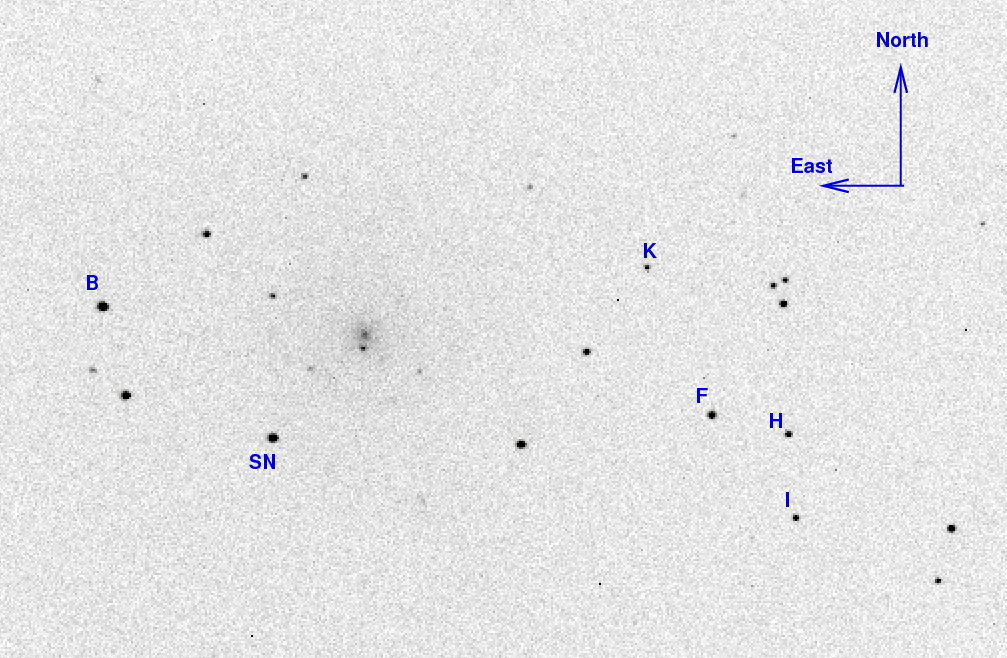
The reference stars marked above have magnitudes in AAVSO chart 12459CA, as follows:
letter B sigB V sigV R sigR I sigI B 13.012 0.019 12.510 0.019 12.154 0.019 11.834 0.019 F 13.848 0.026 13.065 0.022 12.622 0.025 12.152 0.027 H 14.338 0.029 13.692 0.024 13.329 0.029 12.964 0.030 I 14.832 0.027 13.912 0.023 13.416 0.026 12.939 0.030 K 15.192 0.034 14.613 0.027 14.275 0.034 13.915 0.036
I took 30-second guided images -- expect in B-band: the guide star was too faint for the guider to track. After discarding the bad images, I was left with 9, 3, 3 and 4 images in B, V, R, and I, respectively. The V-band images look blotchy; I think that the filter wheel may not have returned to the same position at which the flatfield images were taken early in the evening. I tried using flats from the previous night, but it wasn't really any better.
Using aperture photometry with a radius of 4 pixels (radius of 7.4 arcsec), I measured the instrumental magnitudes of a number of reference stars and the target. Following the procedures outlined by Kent Honeycutt's article on inhomogeneous ensemble photometry, I used all stars available in each image to define a reference frame, and measured each star against this frame. I used the AAVSO magnitudes, plus color terms to convert the ensemble instrumental magnitudes to the standard Johnson-Cousins BVRI scale.
In all passbands, the transformation from instrumental to Johnson-Cousins magnitude had a larger uncertainty than usual. There appeared to be no obvious reason. Perhaps the thin cirrus I saw in the southern sky reached the eastern horizon and M74 during these measurements.
Results from this morning are:
filter mag mag_uncert Julian Date B = 13.351 +/- 0.086 (ens 0.020 zp 0.084) 2456520.68761 V = 12.601 +/- 0.028 (ens 0.015 zp 0.023) 2456520.68091 R = 12.309 +/- 0.043 (ens 0.015 zp 0.040) 2456520.67830 I = 12.149 +/- 0.042 (ens 0.015 zp 0.039) 2456520.68347
The uncertainties here are dominated by transforming the instrumental magnitudes to the standard scale.
Grab the text file below for all the RIT measurements of SN 2013ej. All these values have been recomputed with the new color terms of UT 2013 Aug 05.
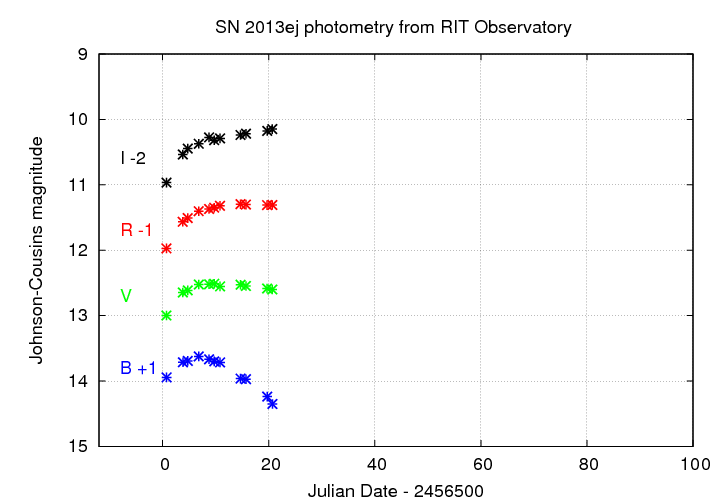
Last modified 08/16/2013 by MWR.